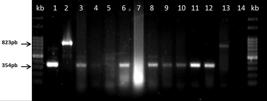ABSTRACT:
Growing and finishing pigs are affected by pathogenic spirochetes of the genus Brachyspira sp., which cause a significant economic impact due to direct and indirect losses. Thus, efficient diagnosis of these species enables better technical intervention to prevent or treat diseases. This study aimed to evaluate the fluorescent in situ hybridization (FISH) for the diagnosis of B. hyodysenteriae and B. pilosicoli in histopathologic fragments of pig’s intestine and compare it to the duplex PCR. Thirty-four samples collected from pigs positive for these species in at least one of the tests were used in the study. Out of the 34 analyzed intestine samples, 28 (82.35%) were positive by PCR and FISH. Among the 29 B. hyodysenteriae positive samples, 23 (79.3%) were positive by PCR and 21 (72.4%) by FISH. There was no statistical difference among the detection rate of the used tests. Based on the fact this technique can be performed in formalin fixed tissue samples, it is practical, fast and allows the association of labeling a specific agent with histological lesions, FISH has become an alternative diagnostic method for Brachyspira hyodysenteriae and B. pilosicoli.
INDEX TERMS:
Fluorescence; hybridization; diagnosis; Brachyspira hyodysenteriae; Brachyspira pilosicoli; swine; pathogenic spirochaetes; in situ molecular diagnostic; swine dysentery; spirochaetal diarrhea

 Thumbnail
Thumbnail
 Thumbnail
Thumbnail
 Thumbnail
Thumbnail


